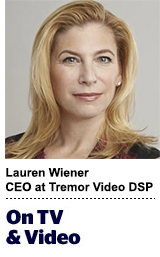
Today’s column is written by Lauren Wiener, CEO at Tremor Video DSP.
Mary Meeker, have we got a new gap for you. Audiences are moving away from traditional television in droves. They are breaking up with their cable companies and starting new relationships with connected TV. But advertiser spending lags behind user behavior.
Connected TV has its challenges – chiefly targeting and segmenting issues, a fragmented buying space and a lack of standardized measurement in audience validation. This isn’t news to players in the space.
To unlock advertiser demand, it is going to take advancements in measurement and more granular targeting. Improvements are in the works, but we have a way to go. Hopefully, as advertiser demand increases, so too will the technology solutions, and we will begin to close the gap.
Connected TV Spending
With media consumption behaviors shifting to digital devices, viewers have been moving away from traditional ways of consuming TV content through their cable providers. The definition of “watching TV” has changed. Many cord-nevers don’t even call it TV – it is video. Already, more households have access to Netflix than a DVR.
Connected TV represented 20% of weekly time spent viewing digital video in the US in August 2016, according to a Frank N. Magid Associates study. In the US, adults spent an average of five hours and 13 minutes watching video (both linear and digital) every day, according to eMarketer.
Right now, 66.5% of US households have connected TVs – that is 82 million households. By 2021, eMarketer forecasts that number will rise to 93.8 million households.
This trend is driven partly by the emergence of linear OTT services, including Sling TV, DirecTV Now, PlayStation Vue, YouTube TV and Hulu with Live TV. Although these emerging digital services are subscription-based, they are not technically “pay TV,” which eMarketer defines as subscriptions to traditional multichannel video programming distributors (MVPDs), as opposed to services that require an internet connection.
While there aren’t any US connected-TV ad spend statistics available, we know anecdotally that it is low. Weekly time spent with connected devices represented 11% of total viewing across linear TV and digital video, according to Nielsen’s Q1 2017 Comparable Metrics Report.
When compared to the time spent for linear TV only, connected TV’s share rose to 13.6%. However, OTT ad spend is estimated to be only about 2-3% of total TV dollars. For OTT/CTV ad spend to be proportionate to the time viewers spend with it, it should be significantly higher than currently levels.
Connected TV is mainstream, but we are observing the same phenomenon as we saw with mobile: Ad spend is lagging behind consumption.
Connected TV Challenges And Solutions
Connected TV holds great promise for marketers, but right now, many can’t see past its limitations, particularly the lack of standardized measurement in audience validation for evaluating campaign reach, impressions and performance, along with data inconsistency across devices and apps.
Marketers are also put off by targeting and segmentation challenges, since connected TV is a cookieless environment with no device ID. There are some solutions in place here, like Neustar, but they don’t offer the level of granularity that other connected devices provide. It’s all done at the household level.
Connected TV’s ad effectiveness measurement is behind compared to other digital platforms. You can’t track and optimize campaigns in real time, metrics are limited and measuring attribution is difficult. Viewability should, in theory, be close to 100%, similar to linear TV, but connected TV campaigns are limited in the fraud, brand safety and viewability measurement capabilities available.
Furthermore, buying connected TV is mostly a manual, I/O-based process, and there is limited premium inventory and scale. Although ownership levels of connected and smart TVs are relatively high, the actual consumption is meager compared to traditional platforms. That is growing rapidly, though, especially among millennials and younger generations.
For example, just two years ago, OTT represented only 8% of digital video ad views. Now, it represents 32%, according to the FreeWheel Video Monetization Report: Q1 2017.
Another factor affecting marketing budgets is that OTT is disconnected from the rest of the TV industry. Buying is fragmented, which is a major obstacle to OTT and linear TV becoming one programmatic buy.
While the challenges connected TV currently face mirror those mobile faced in its nascent stages, so will the solutions. Just as mobile players worked, and continue to work, to address these problems, so, too, will the connected-TV industry.
Connected TV is complex because of the large number of operating systems across different devices and apps. Currently, Nielsen provides some connected-TV campaign-level audience measurement, which allows advertisers to compare reporting across connected TV, mobile, desktop and traditional TV, but it is limited. To advance measurement, we need technology to advance, too.
The measurement challenges will take longer to address because of their complexity, which could slow advertisers’ adoption, as we have seen with mobile. But consumers have spoken, and for marketers looking to reach an engaged audience, this could be a very good thing. Connected TV has tremendous promise: the ability to combine the targeting capabilities of digital with scale on the big screen. Marketers and industry players have to work through these challenges to start closing the connected TV gap.
Follow Lauren Wiener (@LaurenJWiener) and AdExchanger (@adexchanger).
This post was syndicated from Ad Exchanger.
